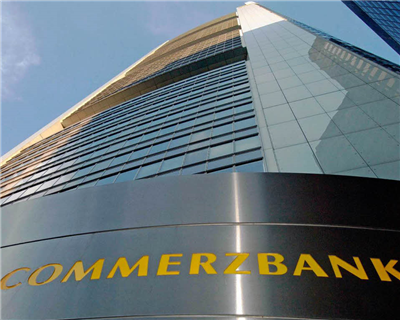Export finance head interview – Commerzbank
TXF talks to Commerzbank about some of the major trends impacting the export credit sector at the present time.

Ralph Lerch, global head of export finance, ~Commerzbank^, in Frankfurt
TXF: What is the present state of the export finance sector, and how is Commerzbank’s business line doing?
Overall the market is encouraging, although we see a pretty stable volume of business rather than any remarkable increase in ECA volumes – so one could say that global business is flatlining. There are also a number of new players in the market and as such more competition. Many  people are chasing the same assets. Overall, there are not enough deals in the market to satisfy all the players. And, because of this, there is considerable pressure on margins – especially for such ECAs which have a solid sovereign rating.
people are chasing the same assets. Overall, there are not enough deals in the market to satisfy all the players. And, because of this, there is considerable pressure on margins – especially for such ECAs which have a solid sovereign rating.
As for our own business line, we are very competitive in terms of raising long-term funding. We have a strong funding base here in Germany, and we benefit from the current situation. In terms of personnel, we have recently placed additional specialists in Amsterdam, Paris, Prague, Shanghai and Tokyo. We are also looking to selectively place originators in the Middle East, South Africa and South-East Asia. We anticipate a degree of momentum taking our business forward. As a group, we come from record levels in export finance having worked hard through the aftermath of the global financial crisis. And we are building our base further. Very recently – on 18 June – we set up a covered bond platform, which will allow us to become more competitive.
The first issue of this was for $500 million with a five- year term. It was pretty quickly oversubscribed, and we had investors from the banking side as well as insurance companies, pension funds and financial institutions from Asia. The underlying assets are export loans backed by Euler Hermes. These transactions are still on our balance sheet. With such a scheme, ideally investors would like to see other agency-backed business also – although this may influence the spread. With the success of this first bond, we are looking to a second issue possibly later in the year. This is a very competitive way to raise long-term funds at the present time.
TXF: How do you view competition currently?
Competition is tough. Many banks succeeded in overcoming funding obstacles or regulatory impact on export finance. If you look at the Japanese banks, they can raise very competitive senior unsecured funding – which is one potential reason why they are so strong in the market at the present time. But also HSBC and Citi are doing well to use their existing international network and structuring expertise.
Our covered bond platform funding solution really helps expand our international network. In addition, being located in Germany gives us a good edge, and we have strong customers which further bolsters our standing.
As for the French banks, we don’t see them as aggressive as in the past. They appear to have quite a cautious approach, but are slowly coming back to play a bigger role. In addition, they are looking at doing refinancing schemes which will further help propel then into the market. I consider the French to have a lot of expertise in this sector.
TXF: How do you see the relationships now between export finance and other products in the armoury of trade banks?
Because of the size of most deals today combined with the internal requirements at banks, no single institution can meet the requirements of export finance as they did in the past. So, a combination Ralph Lerch, global head of export finance, Commerzbank, in Frankfurt of resources and funds are required to meet the funding demands of all those large projects currently in the market. So, bonds are an alternative. Private insurers and other institutional investors can play a role.
We have also explored programmes that MIGA has set up – somewhat similar to those established by private insurers some years ago. This allows them to take comprehensive cover for several transactions. The launching of the non-honouring of sovereign financial obligations cover by MIGA is an appropriate measure which will help the market. We are also linking with Euler Hermes private insurance in certain transactions.And internally we have a link up with the forfaiting side when it is required occasionally.
TXF: How has Commerzbank been affected by regulation?
There is a lot more sensitivity in relation to the issue of the liquidity cover ratio as we get closer to 2018 and full implementation of Basel III. We are keen to convince the European Central bank (ECB) to accept ECA-backed assets and give them favourable treatment, probably positioning ECA assets as HQLA. With all this background and pressure on liquidity cover ratio and net stable funding ratio it was important for us to have our covered bond platform in place.
The export credit business with the agencies is now a lot more transparent than it ever was before. But overall, ECAs globally have very different schemes and products and there probably needs to be much more synchronisation between them.
We are now also starting internal discussions in relation to IFRS 9, to be implemented in 2016 – and this relates to the way banks book and hold assets. This is important in terms of how to handle your overall exposure. We are at the moment pretty cautious and looking at business models of the bank to see how these will cope in different scenarios in the future. But all banks are doing this. So, we also undergo the stress tests as set out by the ECB.
TXF: Where do you think Commerzbank has a real advantage in the market?
Our covered bond platform funding solution really helps expand our international network. In addition, being located in Germany gives us a good edge, and we have strong customers which further bolsters our standing.
TXF: What sectors, countries/regions or clients do you see being major users of export credit/ECAbacked finance in the medium term?
In the near future we see petrochemicals, oil and gas and power generation as being particularly strong sectors. And in the wider sense this comes down to infrastructure where there is a need to really focus. There are a lot of projects in the Middle East. Many of these are so huge that they will require all a range of different funding mechanisms.
As a bank we are going more into Latin America, although we are coming from a rather low level in relation to the region. We are also exploring opportunities much more closely in Africa now too – most notably in Ghana, Angola, Nigeria and South Africa. While in Asia, Indonesia and Vietnam are the primary targets, and it is important to see how Vietnam has come back as an export credit destination recently.
TXF: In what ways have the ECAs changed in the way they operate?
ECAs are far more aware of the investors’ needs today,and have altered their operations to reflect this. The export credit business with the agencies is now a lot more transparent than it ever was before. But overall, ECAs globally have very different schemes and products and there probably needs to be much more synchronisation between them. Going forward, I don’t see ECAs changing their risk appetite in the European context. The direct lending schemes introduced by some agencies – for example by the Korea’s ~Kexim^ and ~US Ex-Im^ – have been very successfully deployed. Other agencies that don’t have such schemes in place obviously wish they did.
This does, however, create pressure. Some of the European agencies can’t do direct lending, and they are limited by budgetary constraints. But I’m optimistic that also in Europe export finance solutions will further been pursued and might be in place soon, which are based on commercial banks involvement. It could also be realistic that ECB or EIB will support long term funding solutions in favour of European exporters. Banks have to be innovative to provide competitive financing solutions to direct lending by ECAs. The scheme introduced by UKEF – in September 2013 – is interesting as an exporter has to prove that commercial banks won’t do the business, and that commercial finance is not available before UKEF can consider the deal.
TXF: How important is it for you to move assets off-balance sheet, and what comment can you make in relation to new investors in export finance and refinancing?
As long as export finance is considered as a core business within Commerzbank it does not require steady outplacement activities. I don’t think that this will change in Commerzbank in the near future, but in today’s environment you have to have as many alternatives as possible for distribution or funding. So, from our perspective it is very welcomed that investors are interested in ECA assets – which in turn provides evidence that the underlying business has a low risk profile.
TXF: How do you see the future prospects for the sector?
The future looks very good. ECA business was very robust and predictable during the crisis. Now we are in a transition period to a more diverse and hopefully less volatile landscape for capex investments worldwide, but the demand for long-term lending is still huge.
The Next article: Export finance head interview – Crédit Agricole CIB
The Previous article: Export finance head interview – Citi






